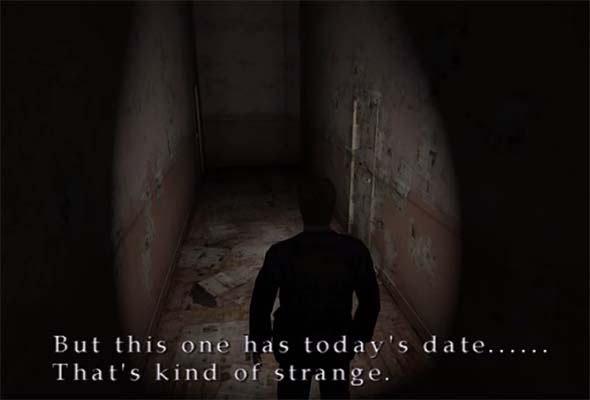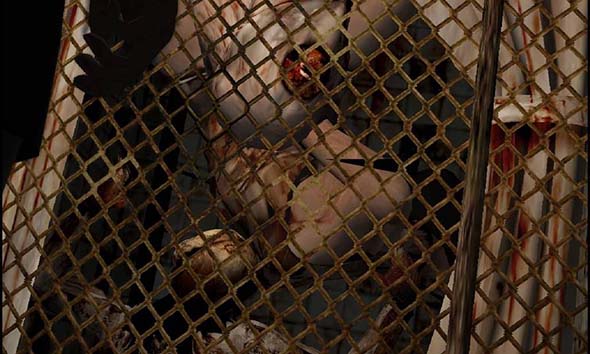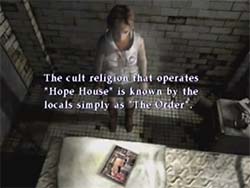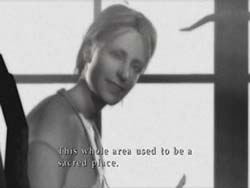
Last year, YouTuber Super Eyepatch Wolf posted a video titled "The Problem with Silent Hill 3: the Downfall of Team Silent". In that video, Super Eyepatch Wolf asserts that the design of Silent Hill 3 changed early in development, as a result of pressure from Konami. He claims that early designs for the game were going to be a more personal, introspective tale, in the vein of Silent Hill 2.
YouTuber Super Eyepatch Wolf posted a video last year asserting that Silent Hill 3
was originally going to be more similar to Silent Hill 2's personal and introspective story and style.
Konami may not have been happy with this early design because -- believe it or not -- there were apparently many vocal fans of the first Silent Hill game who were upset that Silent Hill 2 had not continued the story set forth by the first game. So Konami mandated that Team Silent make Silent Hill 3 be more of a continuation of the first Silent Hill, and so SH3 was re-written as a direct sequel to the first game, and returned to the narrative of a cult trying to birth a demon god.
I've adapted this blog post into a YouTube video response to Super Eyepatch Wolf.
It's hard to believe, but when it was first released, Silent Hill 2 was not universally regarded as the "gold standard" of video game horror. You can look at middling contemporary reviews from publications like Gamespot and GameInformer. In those days, the series was perceived as being "about occultism", and Silent Hill 2 was a stark deviation. Now, with a generation of gamers having grown up playing and loving Silent Hill 2, there's an effort now to re-frame the entire series as having always been about a haunted town torturing the guilty, even though three out of four of the original games are explicitly about a cult trying to re-birth its demon god, and repressed personal guilt is only featured in one of those four games.
Silent Hill 2 was the only of the original 4 games to be about the protagonist being punished for repressed guilt.
But that may not have always been the plan...
If Super Eyepatch Wolf is correct, then Team Silent may have wanted to pivot the narrative focus of the series away from occultism and towards more personal stories like SH2 -- though, importantly, not necessarily about repressed guilt or amnesia!
I have a complicated relationship with the question of "what is Silent Hill about?" Readers of my personal blog will know that I've rigorously defended the idea of Silent Hill (as a series) being about occultism, and that new entries in the series should respect that history, rather than trying to re-frame the entire series (and the nature of the town itself) to be about a haunted town that summons people to face their hidden guilt.
That being said, it isn't that I have a particular attachment to occult stories, even though a lot of the games that I like (such as Demon's Souls and Blooborne) also have strong occult threads. I also am definitely not opposed to more thoughtful, introspective stories. Silent Hill 2 is my favorite game in the series because of that thoughtful, introspective story! Rather, I've found all the third-party-developed games after Silent Hill 4 to be highly derivative of Silent Hill 2 and not particularly good.
Silent Hill 3 pivoted hard back towards the occult inspirations of the first game.
But is that really what Team Silent wanted?
Super Eyepatch Wolf does have some quotes and evidence to support the idea that Silent Hill 3 was originally intended to be a very different game -- all of which was taken from a single interview. But there's not much (if any) information about what the actual story of that game may have been. Nobody on Team Silent has (as far as I know) talked about it, nor do we have a leaked design document like what we have for Silent Hill: Cold Heart (the Wii-exclusive that eventually transformed into Shattered Memories).
... [More]

In the comments of a recent post about Silent Hill 2's Otherworld, I had a discussion with a reader about the time period in which the Silent Hill games take place. This is actually an interesting and difficult topic, so I thought that I would dedicate a post specifically to it.
First and foremost, let's remind ourselves of when the games were released:
| Game title | Original release |
 | Silent Hill | January 1999 |
 | Silent Hill 2 | September 2001 |
 | Silent Hill 3 | May 2003 |
 | Silent Hill 4: the Room | September 2004 |
UPDATE 1 January 2020:
A recent tweet from Masahiro Ito claimed that Silent Hill 2 was set in the "late 70's or early 80's", which would make my estimates about 10 later than Masahiro Ito understood the setting to be. If we take evidence in the first Silent Hill game at face value, this would mean that Silent Hill 2 would have to take place prior to the events of Silent Hill, since Silent Hill can take place no earlier than 1987.
It is also possible that Ito's comment is referring to the aesthetics of the game (in keeping with many of the game's film and literary influences), and not necessarily to its actual timeline. It isn't that I don't trust Ito's memory or his authority, but Team Silent went to great pains to conceal the exact date of the games (as we'll discuss in the following post), so it seems that they wanted the years in which the games take place to be ambiguous to the players -- which kind of makes this entire exercise moot.
Contemporary fiction
It is very important to note that no specific dates ever appear in any of the Silent Hill games that were developed by Konami's internal Team Silent studio. If dates are provided, they are either only the month and day (and not the year), or they are time periods relative to the events of the game (such as referring to the "events of 17 years ago" in Silent Hill 3), or it is just the year of an historical event in the past (such as the document about the sinking of the Little Baroness). Even documents that you would expect to have dates (such as newspapers, journals, diaries, patient reports, and police records) are intentionally left dateless (or at least ambiguous).
In Silent Hill 2, there is a point in which James finds newspapers scattered around a hallway. Upon examining the floor or walls, James comments that the newspapers have today's date. This would have been a perfect opportunity for the developers to provide a specific date for the game, if they wanted to. They could have had James read the date on the paper to the player, or the paper itself (with its date) could have been made clearly visible. The developers didn't do this; they left it completely ambiguous.

James notes that these newspapers have today's date, but doesn't tell us what the date is.
The developers went out of their way to not provide any specific dates for the games. Why would they do this? Typically, works of fiction that are not set in particular time period are written to be contemporary. Unless otherwise specified, most works of fiction should be assumed to take place now with respect to the consumption of the work by its audience, regardless of when "now" happens to be. if it's not contemporary to consumption, then it's usually contemporary to creation. This is usually pretty obvious if the work contains detailed descriptions of locations, technologies, and events that can be easily dated.
If we look at the original Silent Hill game in a vacuum, then the game provides no internal indication that it takes place at any specific time period. Players in 1999 probably had no reason to believe that the game took place in any year other than 1999. The same is true for Silent Hill 2, 3, and 4: if looked at in a vacuum, they can all be considered to take place in the same year that they were released. And if you didn't even know the year that the game was released, there's very little within the games to indicate that they take place at any time other than now.
However, this assumption falls apart because there is an absolute time difference of seventeen years between the events of the first game and the events of the third game, even though the difference in time between releases of the games was only four years. So we can't assume that each game takes place in the year of its release. At least one game has to be shifted on the timeline. So which game (or games) should be assumed to have taken place when? [More]
0ad2a2d3-abbc-4fd7-b255-126a5de4f3ba|8|4.8
Tags:Silent Hill, Silent Hill 2, Silent Hill 3, Silent Hill 4: the Room, history, Harry Mason, Heather Mason, James Sunderland, Maria, Henry Townshend, 1980s, 1990s, 2000s, 1986, 1987, 1994, 1999, 2003, 2008, 2016, Jeep Wrangler, telephone, cell phone, smart phone, rotary phone, computer, television, technology, anachronism, timeline, Konami, Team Silent, The Silence of the Lambs, Mary Shepherd-Sunderland
I frequently hear people bring up the infamous Fukuro video as a counter to my essay on why Silent Hill 2's Pyramid Head isn't a rapist. I haven't addressed this issue in the past because I actually don't know that much about the video or its creation. But I thought I would take a moment to address this issue. First off, let's watch the video in question (warning: contains disturbing content that may not be suitable for sensitive viewers).
This video was made by a small group of Team Silent members, most notably, Masahiro Ito and Akira Yamaoka, and it was included in a documentary DVD titled The Art of Silent Hill. There isn't really much information about this video on the internet other than speculation. As far as I know, Ito and Yamaoka have never made any public statements regarding its relevance to the canon of the games. When asked about the symbolism of the video on Twitter, Ito responded that it abstractly represented the womb.
Does an abstract representation of the womb have any relevance to Silent Hill 2? Not at all. It does, however, have strong ties to Silent Hill 3. In fact, the Fukuro girl character does make a brief appearance in Silent Hill 3! Perhaps Team Silent already had basic designs and outlines in place for Silent Hill 3 when they started work on Silent Hill 2, and the Fukuro video incorporated elements of both?
Fukuro's wiki page asserts that she was a scrapped monster from Silent Hill 2, however no citation is included for this claim, so I can't verify it. The wiki page goes on [without citation] to claim that Fukuro might have been another representation of James' subconscious (along with Pyramid Head). If that is true, then she may have been scrapped because the nurses and / or Maria may have made Fukuro's role superfluous and unnecessary.

the Fukuro Lady appears briefly in an elevator scene in Silent Hill 3.
In any case, if Fukuro had been planned to be a monster symbolic of Jame's repressed sexual frustration, then it seems even less likely that Pyramid Head would also have represented the same element of Jame's subconscious! Pyramid Head and Fukuro's interactions in the Fukuro video could be symbolic of James' sexual desires being a source of guilt for which he wants punishment. In that case, guilt and sexual repression are still separate conditions represented by different manifested creatures that reinforce each other.
Fukuro's necessity in Silent Hill 2 was rendered moot by both Maria and the design of the nurses. It is possible that at some point during the game's design, Pyramid Head's role was intended to be different, and to be more representative of Jame's sexual urges. This could explain the creatures' visual design and the early cutscenes of him "raping" monsters. But as the game's development proceeded, Fukuro was dropped, Maria and nurses were added, and Pyramid Head's role became more explicitly representative of James' guilt and need for self-punishment as a result of Mary's death.
The bottom line is that the Fukuro video and Fukuro character are not in the actual game. At least not in Silent Hill 2. Masahiro Ito may very well believe that Pyramid Head is a sexually-symbolic monster, and he may very well have designed the creature with its Freudian aesthetic with that assumption in place. But for whatever reason, the scenario-writers decided not to pursue that avenue for the remainder of the game. Any lingering sexual symbolism for Pyramid Head is dropped within a couple hours of starting the game, and his role as a punisher is explicitly stated at the end of the game. At best, sexual aggression is a minor, implicit element of Pyramid Head's design; it is certainly not a defining characteristic of the creature, nor is it the creature's primary purpose.
A similar video was also made for Silent Hill 3, and features Robbie the Rabbit. This video also has no relevance to that game's plot.
[More]

In my previous blog entry about the history of Silent Hill's cult, I had originally intended to include a small section about the cult's name, as it is accepted by series fans: "The Order". However, it wasn't really relevant to the specific topic of the in-game cult history, since it is a more meta point about the games in general. So instead, I decided to make it a brief independent article:

Joseph's article is the source of
the name "The Order".
I am one of a subset of Silent Hill fans who does not like using the term "The Order" to refer to the game's cult. For one thing, the name reminds me of the movie and Homecoming, which causes a resentful knee-jerk reaction. But there are also other in-game evidences to suggest that naming the cult might not have been intentional.
The primary source for the name "The Order" comes from an article written by the journalist Joseph Schreiber which details an orphanage that is run by a sect of Silent Hill's cult.
This article is present in Silent Hill 3 as well as Silent Hill 4: The Room, but there are slight differences in the text of the document in each game. Most noticeably, the name of the orphanage changes between the games. In Silent Hill 3 the article appears in a patient room in Brookhaven, and the orphanage name is given as "Hope House". In The Room, however, that same article gives the orphanage the name "Wish House". It was apparently changed sometime in the development of The Room, or it was mistranslated to begin with.
Silent Hill 4 also doesn't give us any indication as to whether the appearance of this article is intended to retcon the article in Silent Hill 3, or if it players are to assume that the actual text of the article changed at some point after the magazine's publication. Perhaps the article was reprinted in a different magazine and the editor or author changed the name. We don't know if it's the same magazine because in Silent Hill 3 the magazine is closed and we only see its cover and never the page of the article, but in Silent Hill 4 the magazine is sitting open on a desk and we see only the page of the article and not the cover.
"The Order" comes from an article that appears in both Silent Hill 3 (LEFT) and Silent Hill 4 (RIGHT).
But if the name of the orphanage changes between versions, can we trust the name of the cult to be correct?
As far as I can remember, "The Order" is never referred to anywhere else in The Room... [More]
9fac77d9-95be-4c33-a431-c4ba4970c07d|6|4.3
Tags:The Order, Silent Hill, Silent Hill 3, Silent Hill 4: the Room, Silent Hill Homecoming, movie, cult, occult, religion, church, Joseph Schreiber

In one of my earlier posts titled "'Silent Hill' is NOT about 'repressed guilt'; it's about occultism!", there seemed to be some misunderstandings about the interpretations that I offered. For one thing, reader Malik commented:
"I have to disagree. The series has never established the cult as the basis for the goings-on in Silent Hill. It is never explicitly stated that the cult or Alessa are the true source of the supernatural power ..."
The commentor is correct on that point. Though, I don't think I ever said that Alessa and the cult were the ultimate source. If you got that impression, then there might have been a misunderstanding or miscommunication, and I apologize for not being clear. To be clear: I was arguing that the plots of the game were focused on the cult and Alessa, and how they affected this supernatural power -- not that the cult is the cause of the power. I thought about responding with my own comment on that original post, but I felt that it would be more appropriate to just write a new blog article about it, so that I could spend more time exploring the town's history, as it was established by the original creators. So, Malik, I hope you read this. and I hope it makes more sense. I'd love to hear your feedback.
Please note that much of this post is speculation. The games themselves provide very little concrete information about the extended history of the cult and region -- especially prior to the Civil War. The following is all retroactive explanation and may not represent the original intentions of the creators. This will be my own, personal opinion and interpretation regarding the nature of Silent Hill's otherworldly power.
The Place of the Silent Spirits
I never intended to imply that the cult and Alessa created the supernatural phenomena, nor that they are the power's ultimate source. I agree that the power likely existed (in some form) far prior to the events of the first game.

Mary refers to Silent Hill as a "sacred place".
Mary's comments regarding the place being "sacred" in the past implies that early inhabitants (probably the Native Americans) were aware of the supernatural effects of the region going back hundreds - maybe thousands - of years. Since the Natives saw the place as being "sacred" and beautiful, I tend to believe that the power did not originally manifest demons or project people's nightmares onto reality during these periods of history. Instead, I would imagine that the force (whether conscious or not) would have been more benign - maybe even benevolent.
We don't know much about the natives' beliefs prior to the arrival of European colonists, and what little we do know is possibly clouded by the lens of the European colonists and cultists.
Based on what is known about real-world Native American beliefs, it is probably safe to assume that the natives of the Toluca Lake region would likely have worshipped any regional supernatural power as "ancestral spirits" or as "spirits of nature". The Book of Lost Memories can be found in Silent Hill 2 after beating the game, and it supports this idea and tells us about the nature spirits:

"They called this place 'The Place
of the Silent Spirits'. By 'spirits',
they meant not only their dead
relatives, but also the spirits that
they believed inhabited the trees,
rocks and water around them."
- Lost Memories book (Silent Hill 2)
The name "Place of the Silent Spirits" may simply be an innocent callback to the game's title, or it could be a significant clue. The fact that the spirits were "silent" implies that the natives were not able to talk to it; or at least, the spirits did not talk back. This implies that the "spirits" are probably not a conscious entity. Even though it can apparently react to the thoughts - and even desires - of the people it comes in contact with, it may not have an intelligence or will of its own (which I explained in my earlier post about repressed guilt)... [More]
643444f5-4ba4-4d6c-818b-921ecc1c7154|8|5.0
Tags:Silent Hill, Silent Hill 2, Silent Hill 3, Silent Hill 4: the Room, history, cult, occult, black magic, religion, spirituality, Christianity, Satan, god, Native Americans, Glooscap, Otherworld, paradise, Maine, colony, Civil War, colonial America, Toluca Lake, tourism, drugs
|

| 12 | | | | | | | 60 | | 11 | | | | | | | 55 | | 10 | | | | | | | 50 | | 09 | | | | | | | 45 | | 08 | | | | | | | 40 | | 07 | | | | | | | 35 | | 06 | | | | | | | 30 | | 05 | | | | | | | 25 | | 04 | | | | | | | 20 | | 03 | | | | | | | 15 | | 02 | | | | | | | 10 | | 01 | | | | | | | 05 |
|